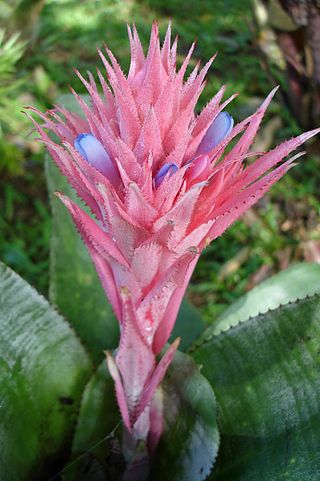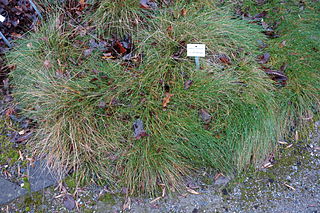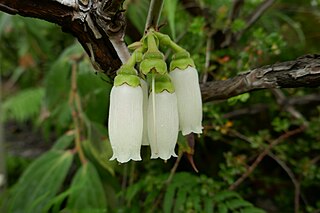
Festuca (fescue) is a genus of flowering plants belonging to the grass family Poaceae. They are evergreen or herbaceous perennial tufted grasses with a height range of 10–200 cm (4–79 in) and a cosmopolitan distribution, occurring on every continent except Antarctica. The genus is closely related to ryegrass (Lolium), and recent evidence from phylogenetic studies using DNA sequencing of plant mitochondrial DNA shows that the genus lacks monophyly. As a result, plant taxonomists have moved several species, including the forage grasses tall fescue and meadow fescue, from the genus Festuca into the genus Lolium, or alternatively into the segregate genus Schedonorus.
There are over 190 vascular plant species on the Norwegian Arctic archipelago of Svalbard. This figure does not include algae, mosses, and lichens, which are non-vascular plants. For an island so far north, this number of species constitutes an astonishing variety of plant life. Because of the harsh climate and the short growing season, all the plants are slow growing. They seldom grow higher than 10 cm (4 in)

Mentha longifolia, also known as horse mint, brookmint, fillymint or St. John's horsemint, is a species of plant in the family Lamiaceae. It is native to Europe excluding Britain and Ireland, western and central Asia, and northern and southern Africa.

Pimelea, commonly known as rice flowers, is a genus of plants belonging to the family Thymelaeaceae. There are about 150 species, including 110 in Australia and 36 in New Zealand.

Pulmonaria longifolia, the narrow-leaved lungwort, is a semi-evergreen clump-forming herbaceous perennial plant, native to western Europe, including Britain, France, Spain, Portugal. It grows in semi-shaded habitats, such as woodland and scrub, to 2000 m above sea level.

Cephalanthera longifolia, the narrow-leaved helleborine, sword-leaved helleborine or long-leaved helleborine, is a rhizomatous herbaceous perennial plant in the family Orchidaceae. It is native to light woodland, and widespread across Europe, Asia and North Africa from Ireland and Morocco to China. This includes the United Kingdom, Iran, Russia, Kazakhstan, Turkey, Algeria, India, Pakistan, Germany, Italy, France, Spain, Portugal and many other countries.

Aechmea is a genus of flowering plants in the family Bromeliaceae. The name comes from the Greek aichme, meaning "spear". Suggested pronunciations include EEK-me-ə and eek-MEE-ə. Aechmea comprises eight subgenera and around 250 species distributed from Mexico through South America and the Caribbean. Most of the species in this genus are epiphytes.

Festuca rubra is a species of grass known by the common name red fescue, creeping red fescue or the rush-leaf fescue. It is widespread across much of the Northern Hemisphere and can tolerate many habitats and climates. It is best adapted to well-drained soils in cool, temperate climates; it prefers shadier areas and is often planted for its shade tolerance. Wild animals browse it, but it has not been important for domestic forage due to low productivity and palatability. It is also an ornamental plant for gardens.

Ryparosa is a genus of plants in the family Achariaceae.

Festuca glauca, commonly known as blue fescue, is a species of flowering plant in the grass family, Poaceae. It is a commonly cultivated evergreen or semi-evergreen herbaceous perennial.

Veronica longifolia, known as garden speedwell or longleaf speedwell, is a flowering plant in the family Plantaginaceae.
NVC community CG1 is one of the calcicolous grassland communities in the British National Vegetation Classification system. It is one of three short-sward communities associated with heavy grazing, within the lowland calcicolous grassland group, and is regarded as the south-west coastal counterpart of "typical" chalk grassland.

Elachista triseriatella is a moth of the family Elachistidae. It is found from Great Britain, Denmark and Latvia to Spain and Italy.

Oxybasis glauca, common name oak-leaved goosefoot, is a species of goosefoot plant native to Europe. It has been introduced and become an invasive weed in North America. This invader of European origin also appears in trampled communities in North Korea.

Coronilla valentina, the shrubby scorpion-vetch, scorpion vetch or bastard senna, is a species of flowering plant in the genus Coronilla of the legume family Fabaceae, native to the Mediterranean Basin, and introduced into Kenya and the United States. It is an evergreen shrub growing to 80 cm (31 in) tall and wide, with pea-like foliage and fragrant, brilliant yellow flowers in spring and summer, followed by slender pods. Linnaeus observed that the flowers, remarkably fragrant in the daytime, are almost scentless at night.

Festuca armoricana, the Breton fescue, is a species of grass endemic to Europe. It was first described in 1975 by Kerguélen.
Blue fescue is a common name for several plant species and may refer to:

Dimorphanthera is a genus of flowering plants belonging to the family Ericaceae.















